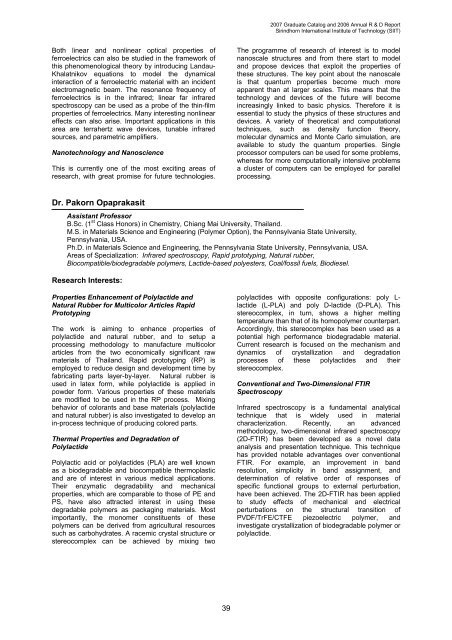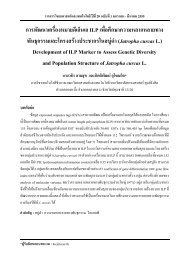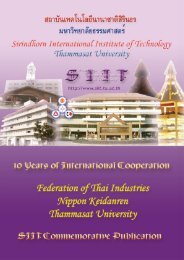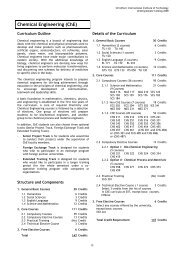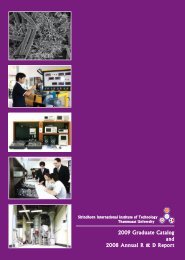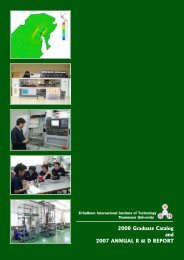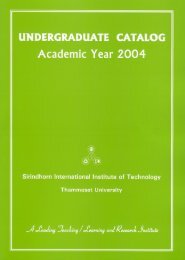2007 Graduate Catalog and 2006 Annual R & D Report - Sirindhorn ...
2007 Graduate Catalog and 2006 Annual R & D Report - Sirindhorn ...
2007 Graduate Catalog and 2006 Annual R & D Report - Sirindhorn ...
You also want an ePaper? Increase the reach of your titles
YUMPU automatically turns print PDFs into web optimized ePapers that Google loves.
<strong>2007</strong> <strong>Graduate</strong> <strong>Catalog</strong> <strong>and</strong> <strong>2006</strong> <strong>Annual</strong> R & D <strong>Report</strong><br />
<strong>Sirindhorn</strong> International Institute of Technology (SIIT)<br />
Both linear <strong>and</strong> nonlinear optical properties of<br />
ferroelectrics can also be studied in the framework of<br />
this phenomenological theory by introducing L<strong>and</strong>au-<br />
Khalatnikov equations to model the dynamical<br />
interaction of a ferroelectric material with an incident<br />
electromagnetic beam. The resonance frequency of<br />
ferroelectrics is in the infrared; linear far infrared<br />
spectroscopy can be used as a probe of the thin-film<br />
properties of ferroelectrics. Many interesting nonlinear<br />
effects can also arise. Important applications in this<br />
area are terrahertz wave devices, tunable infrared<br />
sources, <strong>and</strong> parametric amplifiers.<br />
Nanotechnology <strong>and</strong> Nanoscience<br />
This is currently one of the most exciting areas of<br />
research, with great promise for future technologies.<br />
The programme of research of interest is to model<br />
nanoscale structures <strong>and</strong> from there start to model<br />
<strong>and</strong> propose devices that exploit the properties of<br />
these structures. The key point about the nanoscale<br />
is that quantum properties become much more<br />
apparent than at larger scales. This means that the<br />
technology <strong>and</strong> devices of the future will become<br />
increasingly linked to basic physics. Therefore it is<br />
essential to study the physics of these structures <strong>and</strong><br />
devices. A variety of theoretical <strong>and</strong> computational<br />
techniques, such as density function theory,<br />
molecular dynamics <strong>and</strong> Monte Carlo simulation, are<br />
available to study the quantum properties. Single<br />
processor computers can be used for some problems,<br />
whereas for more computationally intensive problems<br />
a cluster of computers can be employed for parallel<br />
processing.<br />
Dr. Pakorn Opaprakasit<br />
Assistant Professor<br />
B.Sc. (1 st Class Honors) in Chemistry, Chiang Mai University, Thail<strong>and</strong>.<br />
M.S. in Materials Science <strong>and</strong> Engineering (Polymer Option), the Pennsylvania State University,<br />
Pennsylvania, USA.<br />
Ph.D. in Materials Science <strong>and</strong> Engineering, the Pennsylvania State University, Pennsylvania, USA.<br />
Areas of Specialization: Infrared spectroscopy, Rapid prototyping, Natural rubber,<br />
Biocompatible/biodegradable polymers, Lactide-based polyesters, Coal/fossil fuels, Biodiesel.<br />
Research Interests:<br />
Properties Enhancement of Polylactide <strong>and</strong><br />
Natural Rubber for Multicolor Articles Rapid<br />
Prototyping<br />
The work is aiming to enhance properties of<br />
polylactide <strong>and</strong> natural rubber, <strong>and</strong> to setup a<br />
processing methodology to manufacture multicolor<br />
articles from the two economically significant raw<br />
materials of Thail<strong>and</strong>. Rapid prototyping (RP) is<br />
employed to reduce design <strong>and</strong> development time by<br />
fabricating parts layer-by-layer. Natural rubber is<br />
used in latex form, while polylactide is applied in<br />
powder form. Various properties of these materials<br />
are modified to be used in the RP process. Mixing<br />
behavior of colorants <strong>and</strong> base materials (polylactide<br />
<strong>and</strong> natural rubber) is also investigated to develop an<br />
in-process technique of producing colored parts.<br />
Thermal Properties <strong>and</strong> Degradation of<br />
Polylactide<br />
Polylactic acid or polylactides (PLA) are well known<br />
as a biodegradable <strong>and</strong> biocompatible thermoplastic<br />
<strong>and</strong> are of interest in various medical applications.<br />
Their enzymatic degradability <strong>and</strong> mechanical<br />
properties, which are comparable to those of PE <strong>and</strong><br />
PS, have also attracted interest in using these<br />
degradable polymers as packaging materials. Most<br />
importantly, the monomer constituents of these<br />
polymers can be derived from agricultural resources<br />
such as carbohydrates. A racemic crystal structure or<br />
stereocomplex can be achieved by mixing two<br />
polylactides with opposite configurations: poly L-<br />
lactide (L-PLA) <strong>and</strong> poly D-lactide (D-PLA). This<br />
stereocomplex, in turn, shows a higher melting<br />
temperature than that of its homopolymer counterpart.<br />
Accordingly, this stereocomplex has been used as a<br />
potential high performance biodegradable material.<br />
Current research is focused on the mechanism <strong>and</strong><br />
dynamics of crystallization <strong>and</strong> degradation<br />
processes of these polylactides <strong>and</strong> their<br />
stereocomplex.<br />
Conventional <strong>and</strong> Two-Dimensional FTIR<br />
Spectroscopy<br />
Infrared spectroscopy is a fundamental analytical<br />
technique that is widely used in material<br />
characterization. Recently, an advanced<br />
methodology, two-dimensional infrared spectroscopy<br />
(2D-FTIR) has been developed as a novel data<br />
analysis <strong>and</strong> presentation technique. This technique<br />
has provided notable advantages over conventional<br />
FTIR. For example, an improvement in b<strong>and</strong><br />
resolution, simplicity in b<strong>and</strong> assignment, <strong>and</strong><br />
determination of relative order of responses of<br />
specific functional groups to external perturbation,<br />
have been achieved. The 2D-FTIR has been applied<br />
to study effects of mechanical <strong>and</strong> electrical<br />
perturbations on the structural transition of<br />
PVDF/TrFE/CTFE piezoelectric polymer, <strong>and</strong><br />
investigate crystallization of biodegradable polymer or<br />
polylactide.<br />
39


